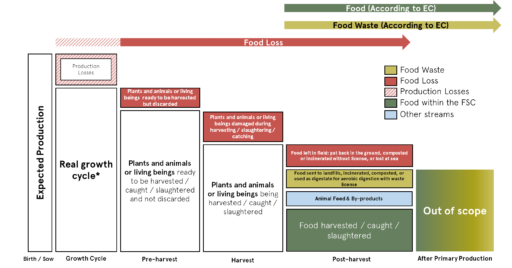07/11/2023
One of the main objectives of the project is to identify food flows that are discarded within the agri-food chain, which are currently not included in the mandatory measurements for different states by the European Union, as they do not consider anything “food” until it’s harvested. Consequently, all discards, mainly during and prior to the harvesting process, are left out. From our perspective, this situation conceals a problem for farmers and society in general, which we could initially refer to as “food losses.” Therefore, to provide an effective solution, before we need to understand the issue of food losses.
To achieve this, firstly, we have defined the boundaries of this analysis, i.e., what constitutes “food losses” (Figure 1). As said, food losses will arise mainly in the pre-harvest and harvest stage, as those products that reach a stage of maturity but are not harvested for different reasons. Additionally, there are flows of food lost during the post-harvest stage that cannot be clearly labelled as food waste or by-products, and we are researching whether those flows should also be food losses. However, this initial definition will be collectively improved during the length of the project, as a result of the case studies and the discussion tables that are being organized.

Figure 1. Food Loss Definitional Framework
Secondly, we had to create a measurement protocol so that a public administration (from a company, city, region, or country) or even an individual farm can tackle the challenge of measuring these food losses. This has been an attempt to answer the WHAT, WHERE, HOW, and WHEN to measure despite the complexity of measuring such different realities as types of food commodities and territories. This is indeed a formidable challenge, but the goal is to establish a methodological framework that can be applied uniformly throughout the European Union and beyond, enabling us all to measure the problem similarly and, in turn, gain a better understanding of it.
The next steps to be taken involve the review of these two documents by world-renowned experts in this field, hailing from various parts of the globe, in order to encompass different perspectives, issues, and peculiarities. Additionally, this measurement protocol will also be validated and improved through several case studies involving different types of foods, which will be conducted during the FOLOU project at various locations within the European Union.